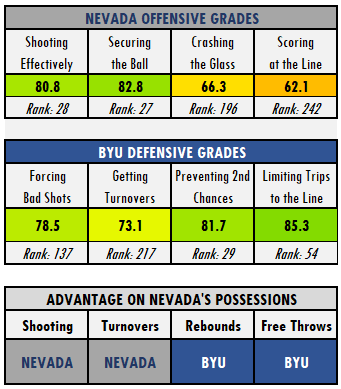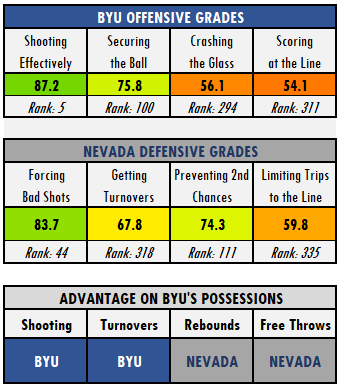[jwplayer 18QegcJn-sNi3MVSU]
Five for ’21: Ranking The Mountain West’s Top Five Shot Blockers
Predicting the top five Mountain West shot blockers for the ’20-21 season
Contact/Follow @andrewdieckhoff & @MWCwire
Who are the top shot blockers in the MW?
In the third installment of Mountain West Wire’s offseason series, Five for ’21, we shift our focus from the league’s offensive stars onto its defensive stalwarts.
As a reminder, the Five For ’21 series features our ranking of the top five Mountain West players in five different skill sets: passing, scoring, defending, rebounding, and shot blocking. The full Five For ’21 series schedule is below, including links to this week’s previous articles from Larry Muniz (Twitter: @hardwoodtalk).
Today, we focus on the Mountain West’s top shot-blockers. This list has a distinctly international feel, so it is fitting that we start our countdown with one of the league’s most well-traveled players, whose long trip from Belgrade to Boise features a two-year stop in the Volunteer State.
5) Mladen Armus, Boise State
- Height/Weight: 6’10”, 230 lbs.
- 2018-19 (at ETSU): 33 GP (24 GS), 1.0 BPG, 5.5 BLK%, 4.6 FC/40
After spending two seasons in the SOCON at East Tennessee State, the 6-10 Armus decided to pack his bags and head west to ride with the Broncos, where he will have two years of eligibility remaining after sitting out last season. In his sophomore season for ETSU, Armus racked up nearly eight points and eight rebounds per game and became a fixture in the starting lineup — and not just for his serviceable offensive game.
The Serbian center showed steady improvement on defense in his second year in Johnson City, tallying just under two “stocks” (steals plus blocks) per game in 2018-19. As a freshman, Armus’ block percentage in SOCON games was just 1.4% — for reference, Justinian Jessup finished last season with a 1.6 BLK% — but he brought that number up to 5.9% in SOCON play last season and 5.5% overall, which would have been good for fifth-best in the Mountain West last year.
Armus could fill a huge role for Boise State on defense in 2020-21. While RJ Williams was able to make up for the team’s lack of size last season with a remarkable tenacity and instinct for rebounding, his 6’7″ stature didn’t translate to many blocks. With Derrick Alston Jr. back for one more year, and plenty of offensive support from Abu Kigab, Marcus Shaver, Devonaire Doutrive, and Emmanuel Akot, Armus will be relied upon to be the defensive anchor down low that Leon Rice needs to round out this talented roster.
4) K.J. Hymes, Nevada
- Height/Weight: 6’10”, 210 lbs.
- 2019-20 Stats: 31 GP (1 GS), 1.0 BPG, 8.7 BLK%, 9.5 FC/40
Hymes came into his first season in Reno with some considerable hype, after being pegged as the preseason Mountain West Freshman of the Year. Unfortunately for the Phoenix native, he never quite lived up to that billing. For Hymes, the issue was not so much about talent or athleticism, but discipline in defending. He averaged just under 14 minutes per game as a freshman behind BC grad transfer Johncarlos Reyes, and Hymes likely would have seen a larger share of playing time had he been able to stay out of foul trouble.
But when Hymes does stay on the floor, he can be a nightmare for would-be scorers entering into his airspace. All that time in the penalty box (so to speak) kept the big man from qualifying in the Mountain West’s statistical races, but if the threshold is lowered to include all players who appeared in more than a third of their team’s total minutes last year, Hymes had the best block percentage in the Mountain West by a decent margin, beating out Neemias Queta’s mark by almost a full percentage point.
The shot-blocking talent is certainly there for Hymes, but it is difficult to swat anything from the bench. If he can develop some more defensive discipline as a sophomore, he should find a welcome home into Steve Alford’s starting five. The question then becomes whether the impressive statistics will carry over to a larger sample size, of course, but there is good reason to believe that Hymes will be among the five best shot-blockers in the Mountain West in 2020-21.
3) Cheikh Mbacke Diong, UNLV
- Height/Weight: 6’11”, 235 lbs.
- 2019-20: 32 GP (27 GS), 1.2 BPG, 6.0 BLK%, 4.6 FC/40
Over the course of three seasons in Las Vegas, Diong has become an absolute difference maker for the Runnin’ Rebels. While the Senegalese senior is no threat to win a scoring title anytime soon, his tough interior play has allowed him to become one of the league’s top defensive big men. Diong’s 7.5 BLK% during Mountain West play last year was second only to Utah State’s Neemias Queta (7.9) among qualified players, and his steal percentage was fourth-highest in the conference.
Diong’s imposing physical presence has always made him a bulwark in the post, but his improved timing and positioning helped the center finish just outside the Top 100 nationally in block percentage the past two seasons, as well as a Top 50 finish in offensive rebounding. He was also one of only four Mountain West players to record three or more games with 10+ points, 10+ rebounds, and 2+ blocks last year (Justin Bean, Nate Grimes, and Neemias Queta being the others).
A hard-nosed grinder, Diong has carved out a solid niche for himself on this UNLV roster, which does lose some size and physicality with the departures Donnie Tillman, Nick Blair, and Vitaly Shibel. While Diong’s offensive game has improved to some degree, players such as Bryce Hamilton, David Jenkins Jr., and Marvin Coleman should be carrying the scoring load, freeing the big man up to continue honing his blue-collar craft on defense.
2) Neemias Queta, Utah State
- Height/Weight: 7’0″, 245 lbs.
- 2019-20: 22 GP (20 GS) 2.6 BPG, 7.8 BLK%, 3.5 FC/40
While others may have had better numbers in smaller sample sizes, it was Queta who will go down as the Mountain West’s best shot-blocker of 2019-20. Despite missing multiple games himself due to an offseason injury, Queta was able to secure enough minutes on the season to let his 7.8 BLK% rule the day. Unfortunately for the Portuguese big man, he had to relinquish his MW Defensive Player of the Year crown to San Diego State’s Malachi Flynn. But he’ll have his eyes set on getting it back in 2020-21.
There is some cause for concern about Queta’s shot-blocking, however. In his freshman season at Utah State, he recorded a 10.5 BLK%, which was easily the best in the league and Top 20 in Division I. However, following the knee injury Queta suffered during FIBA play in the summer of 2019, some of the spring seemed to have gone out of his step. But Queta returned to form down the stretch, recording at least one block in 12 of his last 13 games, with multiple blocks coming in ten of those contests.
Even after accounting for the dip in Queta’s post-injury block percentage, the junior seven-footer is still undoubtedly one of the two best post defenders in the Mountain West. But with Sam Merrill gone, it will be more important than ever to keep Queta out of foul trouble, which could mean he has to trade some of the defensive risk-taking that has earned him so many blocks in his first two years in Logan.
1) Nathan Mensah, San Diego State
- Height/Weight: 6’10”, 220 lbs.
- 2019-20: 13 GP (13 GS); 1.7 BPG, 10.7 BLK%, 4.9 FC/40
In a cruel (and scary) twist of fate, the tremendous start to Mensah’s season was cut short by a pulmonary embolism that was thankfully caught before the situation turned any more tragic. The Aztecs were still perfect at that point, and we will simply never know what could have been had Mensah been able to play for the full season, both for the team and individually. (Go ahead and add all that to the list of things we’ll never know about the 2019-20 season.)
Here’s what we do know: Nathan Mensah was on a trajectory to be the league’s best shot-blocker before his season was ended early. His 10.7 BLK% would have led the league by a full two points had he kept that pace for the long haul, and it would have placed him somewhere in the back end of the Top 20 nationally. While Queta had the minutes to qualify for the season-long statistical races, it was Mensah who began to blossom into the Mountain West’s most elite shot-blocker on a per-minute basis.
Of course, Mensah’s health remains a question mark, as updates regarding his recovery have been scarce. Thankfully, the stories have been trending in a positive direction since January, and all indications point to him returning to the Aztecs’ lineup whenever the college basketball season resumes. If the Nathan Mensah Block Party does resume on time, San Diego State will be well-positioned to defend last year’s regular-season crown. With any luck, Mensah can finally put to rest some of those nagging what-ifs from 2020.
Also considered (in alphabetical order): Desmond Cambridge, Nevada; Assane Diouf, Fresno State; Trevin Dorius, Utah State; Kuba Karwowski, Utah State; Eduardo Lane, San Jose State; Bayron Matos, New Mexico; Braxton Meah, Fresno State; Orlando Robinson, Fresno State; David Roddy, Colorado State; Warren Washington, Nevada.
Andrew Dieckhoff is a current USBWA member covering college basketball for Mountain West Wire. He also runs the Dieckhoff Power Index, a website dedicated to his college basketball ratings system and bracketology projections.
[lawrence-auto-related count=3 category=1361]
[protected-iframe id=”09e6ca4e11e5838c3834d87c7b471ffb-137729785-123448869″ info=”https://anchor.fm/mwwire/embed” width=”400px” height=”102px” frameborder=”0″ scrolling=”no”]



